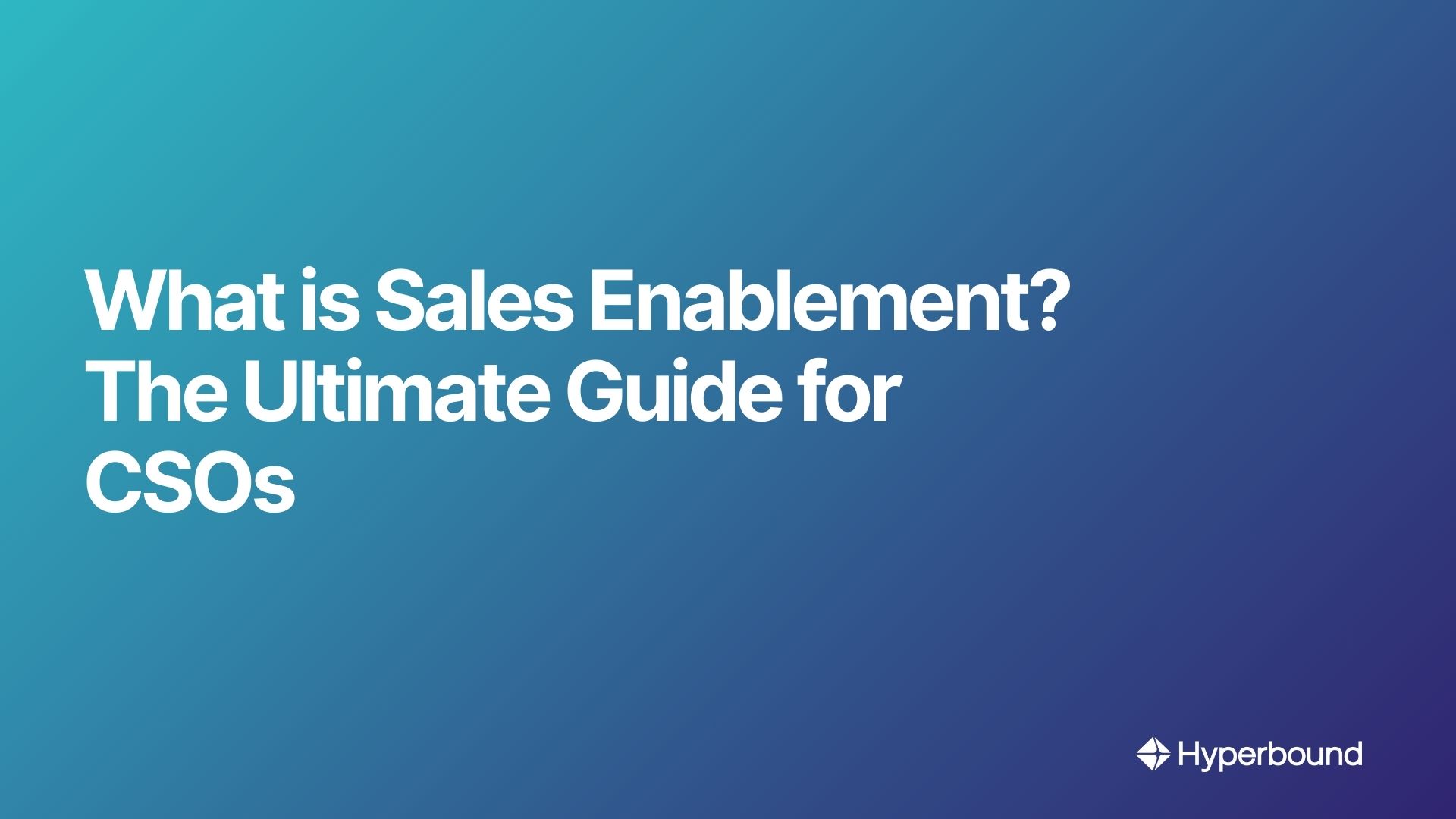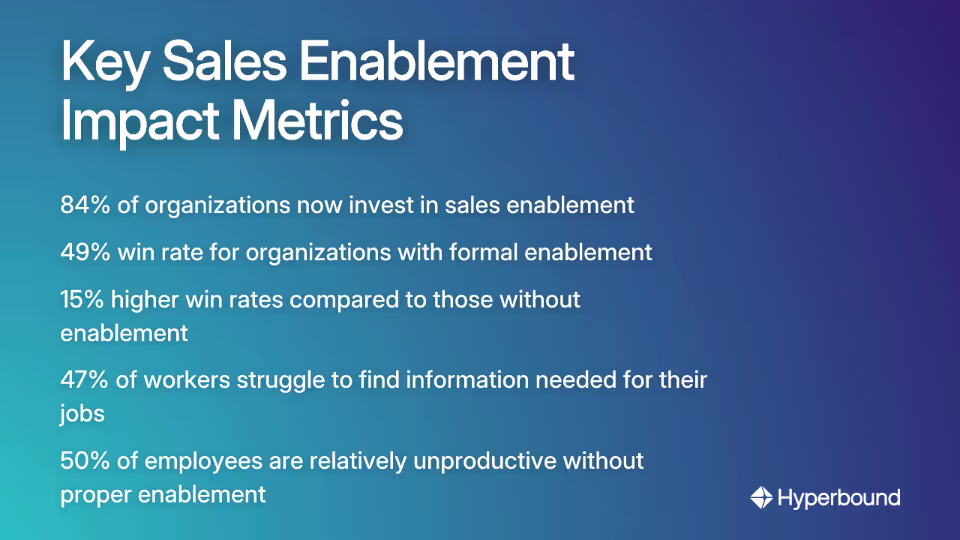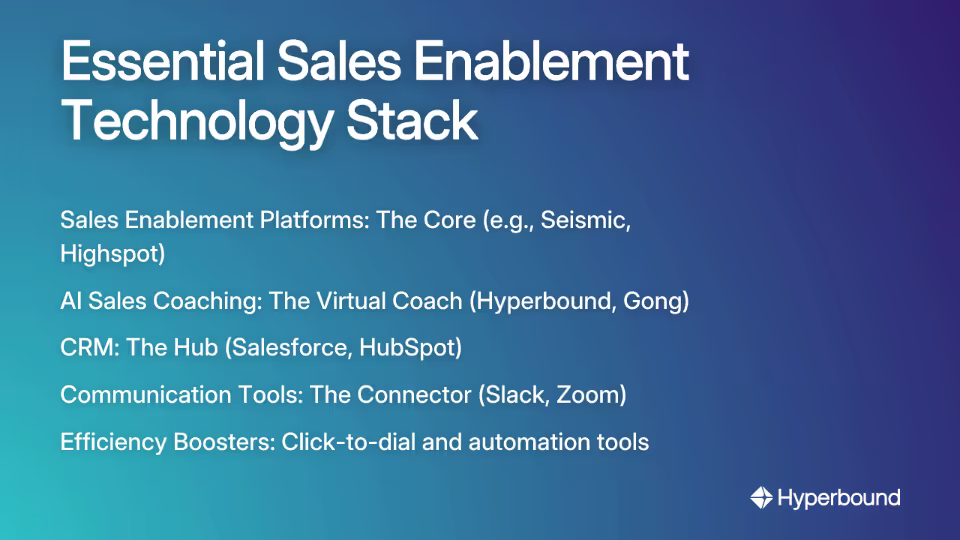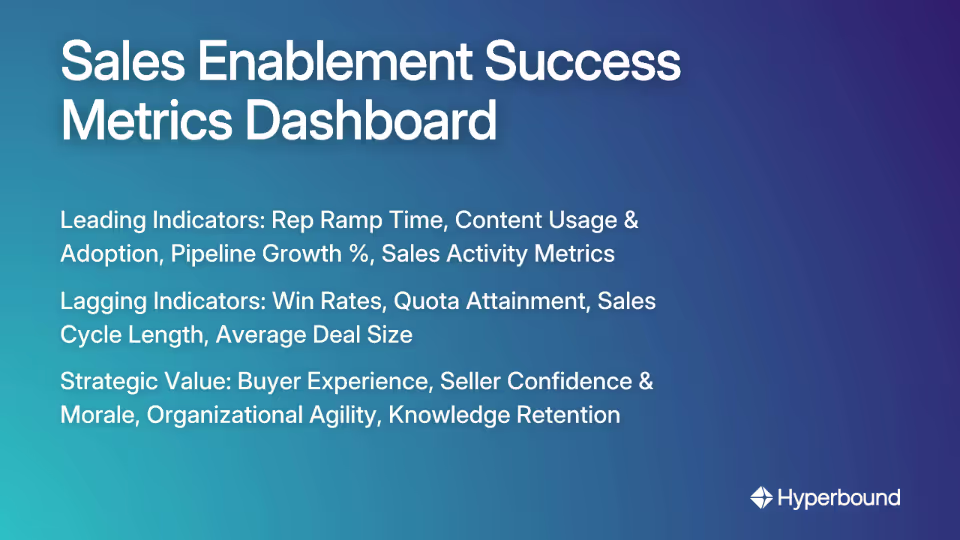
You're feeling the pressure. Revenue targets keep climbing, yet your sales team is struggling to consistently hit quota. New reps take forever to ramp up, and when economic uncertainty looms, the board starts questioning every non-revenue generating function—including your sales enablement team.
Sound familiar? You're not alone.
"When things get rocky, this is one of the first functions that will be cut," notes a sales leader in a recent discussion. Yet paradoxically, a well-executed enablement strategy may be your most powerful lever for building a predictable, scalable revenue engine.
This guide will reframe how you view sales enablement—not as a dispensable support function, but as the strategic foundation that determines whether your sales organization thrives or merely survives.
What is Sales Enablement? A Definition for the C-Suite
Let's define enablement in clear terms that resonate with executive leadership:
Sales enablement is a strategic, cross-functional discipline that equips your entire GTM team with the training, content, coaching, and tools they need to effectively engage buyers throughout their journey and consistently close more deals, faster.
Unlike traditional sales training (a one-time event) or sales operations (focused on processes and systems), enablement creates a continuous framework for sales excellence that adapts as your market evolves.
The Undeniable Business Case: From Cost Center to Revenue Driver
If you're still viewing enablement as merely a cost center, you're missing the bigger picture. The data tells a compelling story:
- 84% of organizations now invest in sales enablement, making it a competitive necessity, not a luxury (Mindtickle CRO + Sales Leader Outlook Report)
- Organizations with formal enablement achieve a 49% win rate on forecasted deals—significantly higher than the 42.5% for those without it (Sales Enablement Collective)
- Another study found that organizations with sales enablement have win rates 15% higher than those without it (Showpad/CSO Insights)
Beyond these headline metrics, enablement directly addresses critical operational drags on revenue:

Solving the Information Gap
Gartner found that 47% of digital workers struggle to find the information needed to do their jobs effectively (Gartner). Enablement creates a single source of truth for content and knowledge.
Addressing the Productivity Drain
McKinsey research indicates over 50% of employees are "relatively unproductive" (McKinsey). Enablement streamlines processes so your sales reps can focus on selling, not searching for information or reinventing the wheel.
The Growth Multiplier
As one sales leader put it: "A good sales enablement team in a fast-growing company prints money. The faster you get new reps to quota, the faster you grow. It is a huge differentiator when done right." (Reddit)
The Four Pillars of a World-Class Sales Enablement Strategy
Before diving into the components of a robust enablement strategy, let's clarify what enablement is—and isn't—to avoid confusion:
Enablement vs. Adjacent Functions
- Sales Enablement vs. Sales Operations (Rev Ops): Sales Enablement is people-centric, focusing on improving seller effectiveness and readiness. Rev Ops is process-centric, focusing on the tech stack, territory planning, and backend processes (Sales Enablement Collective).
- Enablement vs. Sales Training: Sales training programs (like Sandler Training or Value Selling) are components of enablement, but enablement is the overarching strategy that encompasses continuous coaching, content, and tools for long-term success.
Now, let's examine the four pillars that form the foundation of world-class enablement:
Pillar 1: Talent Development (Onboarding & Continuous Coaching)
Objective: Systematically decrease new hire ramp time and increase overall team quota attainment.
Many organizations still rely on a "trial by fire" approach to onboarding: "Either learn on your own time and pick it up and start closing deals, or get the axe," as one sales rep described their experience (Reddit).
A structured talent development program includes:
- Structured Onboarding: A methodical 30-60-90 day plan with clear milestones and expectations
- Skills-Based Training Modules: Targeted to address specific challenges:
- Opportunity Qualification: Implementing frameworks like MEDDIC or MEDDPICC to prevent opportunities that "would just die—often with being ghosted by the prospect" (Reddit)
- Situational Fluency: Developing specific talk tracks for "combating up-and-coming competitors, framing new products/releases, providing talk tracks for changes in pricing" (Reddit)
- Resilience Coaching: Sessions on how to "rebound better after losing a sale," a crucial skill for long-term success (Reddit)
- Ongoing Coaching & Certification: Regular role-play scenarios, call reviews, and certification programs are essential for continuous improvement. Leading teams now leverage AI to scale these efforts, providing reps with realistic practice environments and instant feedback to master skills faster.
Pillar 2: Strategic Content Management
Objective: Equip reps with the right content, at the right time, to move deals forward.
One of the most common pain points for sales teams is "struggling with finding and accessing high-quality sales enablement materials" (Reddit). A robust content management strategy includes:
- Single Source of Truth: A centralized, easily searchable content repository
- Content Mapped to Buyer's Journey: Materials designed for each stage of the sales process
- Sales-Ready Assets: From case studies and competitor battle cards to proposal templates and curated recordings of best-practice calls
- Just-in-Time Delivery: Content pushed to reps when they need it, based on deal stage or buyer interactions
Pillar 3: The Technology Stack
Objective: To provide the technological backbone that automates tasks, delivers insights, and streamlines workflows.
The use of sales enablement tools increased by 48% in 2024, and 75% of reps believe these tools help them meet their quotas (Salesforce). A comprehensive enablement tech stack includes:

- Sales Enablement Platforms (The Core): Solutions like Seismic or Highspot that serve as the central hub for content and broad training initiatives.
- AI Sales Coaching (The Virtual Coach): Advanced platforms like Hyperbound analyze winning behaviors from your call data and use AI to create hyper-realistic roleplays. These tools provide a safe, scalable environment for reps to practice, get instant feedback, and master your playbook. Other tools in the conversation intelligence space include Gong and Chorus.
- CRM (The Hub): Salesforce Sales Cloud, HubSpot Sales Hub, or similar platforms that track customer relationships
- Communication Tools (The Connector): Slack, Zoom, and other platforms that facilitate collaboration
- Efficiency Boosters: For teams with high volume cold calling, features like click to dial are non-negotiable (Reddit)
Pillar 4: Cross-Functional Alignment & The Rise of Revenue Enablement
Objective: To ensure a consistent, seamless customer experience by breaking down silos.
As a CSO, you must foster deep collaboration between Sales, Marketing, Product, and Customer Success (310creative). This is increasingly leading to the evolution of "revenue enablement"—expanding the scope beyond sales to align all customer-facing teams under a single enablement strategy.
This shift reflects the observation that "The role has shifted from a focus on sales enablement to a broader scope known as revenue enablement" (Reddit). Revenue enablement recognizes that the customer journey spans multiple departments, and all touchpoints must be orchestrated for maximum impact.
A CSO's Playbook: Implementing a High-Impact Enablement Function
Now that we understand the components of effective enablement, let's explore a step-by-step implementation playbook for CSOs:
Step 1: Define the Charter & Align with Business Goals
Before hiring anyone or purchasing any technology, get C-suite alignment on the enablement function's purpose. What top-level business outcome will it drive? For example:
- Increase win rates in enterprise tech sales by 10%
- Reduce new hire ramp time by 30%
- Increase average deal size by 15%
Set SMART goals and ensure they're directly tied to your organization's strategic priorities (Sales Enablement Collective, 310creative).
Step 2: Conduct "Listening Tours" to Diagnose Pain
This is perhaps the most critical step. Mandate that your enablement leader's first 30 days are spent interviewing reps, managers, and cross-functional partners to identify:
- Where do your sales reps waste the most time?
- What content or tools are missing?
- What are the most common objections or challenges in sales conversations?
This approach embodies the advice to "get some time with the current reps and ask them what they feel they're lacking" (Reddit). These listening tours not only provide invaluable insights but also build buy-in and ensure solutions are relevant to real-world needs.

Step 3: Build the Team and Structure
Define who is responsible for enablement. The team typically reports to the CRO/CSO and includes:
- Enablement Professionals who act as project managers for sales leaders who are too busy with deal strategy (Reddit)
- Learning & Development specialists focused on training and certification
- Content specialists who create and curate sales-ready materials
- Technology administrators who manage the enablement tech stack
The size and structure of your team will depend on your organization's size, complexity, and budget, but even a small team can drive significant impact if focused on the right priorities.
Step 4: Design, Deliver, and Iterate
Based on the insights from your listening tour, build solutions that address the most pressing pain points:
- Quick Wins: Start with high-impact, low-effort initiatives to build momentum
- Content Assessment: Audit existing content and identify gaps
- Training Design: Develop role-based training programs
- Technology Selection: Choose tools that integrate with your existing stack
- Pilot Programs: Test approaches with a small group before rolling out company-wide
Crucially, establish feedback loops to continuously improve. Don't let content or training become stale. Use data analytics to see what's working and what's not (Whatfix).
Step 5: Drive Adoption Through Accountability
The most brilliant enablement program is worthless if no one uses it. Drive adoption through:
- Executive Sponsorship: Visibly use and champion enablement resources
- Manager Reinforcement: Hold frontline managers accountable for coaching with enablement tools
- Recognition Programs: Reward reps who leverage enablement resources
- Data Transparency: Share usage metrics and correlations with performance
- Continuous Communication: Regular updates on new resources and success stories
Remember, adoption is not a one-time event but an ongoing process that requires consistent attention and reinforcement.

Measuring What Matters: Proving the ROI of Sales Enablement
As a CSO, you need a clear framework for measuring the success of your enablement initiatives. Here's how to build your dashboard:

Quantifiable ROI: Leading & Lagging Indicators
Leading Indicators (Predictive of Future Success):
- Rep Ramp Time: The time for a new rep to become fully productive (Salesforce)
- Content Usage & Adoption: Are reps using the materials? (50% of enablers track this) (Sales Enablement Collective)
- Pipeline Growth %: Is the pipeline expanding as a result of enablement initiatives?
- Sales Activity Metrics: Call volume, meeting conversions, proposal submissions
Lagging Indicators (Historical Performance):
- Win Rates: The ultimate measure of effectiveness (40.54% of enablers track this)
- Quota Attainment: Percentage of the team hitting their number (39.19% of enablers track this)
- Sales Cycle Length: Is enablement helping deals close faster? (29.73% of enablers track this)
- Average Deal Size: Are reps being enabled to sell larger, more strategic deals?
"Unquantifiable" ROI: The Strategic Value
Beyond the hard metrics, there are strategic benefits that are more difficult to quantify but no less important:
- The Buyer Experience: In modern B2B sales, experience often trumps price. 84% of companies that improve customer experience report revenue increases (Showpad/Dimension Data). Great enablement creates great experiences by ensuring your team can deliver value at every interaction.
- Seller Confidence & Morale: A confident, well-equipped team performs better and has lower attrition. When reps know they have the resources to succeed, they're more likely to stay and thrive.
- Organizational Agility: Strong enablement functions help organizations pivot quickly in response to market changes, competitive threats, or product launches.
- Institutional Knowledge Retention: By capturing best practices and tribal knowledge, enablement ensures that critical insights aren't lost when top performers leave.
Practical Implementation: Real-World Examples
Let's examine how effective enablement strategies have transformed real sales organizations:
Case Study 1: Reducing Ramp Time in Enterprise Tech Sales
A high-growth SaaS company struggled with 9-month ramp times for new enterprise sales reps. By implementing a structured enablement program that included:
- Role-specific onboarding with clear 30-60-90 day expectations
- A library of call recordings showing top performers handling common objections
- Weekly role-play sessions on competitive positioning
- A mentorship program pairing new hires with seasoned reps
The company reduced ramp time to 5 months, increasing first-year productivity by 47% and saving over $2 million in opportunity cost.
Case Study 2: Improving Win Rates Through Content Strategy
A B2B services firm found that their win rates were lagging industry benchmarks. Through their enablement function, they:
- Conducted win/loss analyses to identify content gaps
- Created industry-specific value proposition templates
- Developed interactive ROI calculators tailored to different buyer personas
- Established a regular cadence of competitive intelligence updates
The result? Win rates improved by 12 percentage points over 6 months, driving $4.3 million in incremental revenue.
Case Study 3: Scaling Through Revenue Enablement
A mid-market technology provider needed to scale rapidly while maintaining quality. By evolving from sales enablement to revenue enablement, they:
- Aligned messaging across marketing, sales, and customer success
- Created a unified content repository accessible to all customer-facing teams
- Implemented cross-functional certification programs
- Established shared KPIs across the customer lifecycle
This approach reduced customer acquisition costs by 18% while improving retention rates by 23%, creating a sustainable growth engine.
The Future of Sales Enablement: Trends to Watch
As you build your enablement strategy, keep these emerging trends in mind:
AI-Powered Enablement
Artificial intelligence is transforming enablement, and platforms like Hyperbound are at the forefront of this shift. AI is now critical for:
- Scalable Practice & Coaching: Creating hyper-realistic AI roleplays based on your own top performers, allowing reps to practice any scenario on-demand and receive instant, objective feedback without manager oversight.
- Automated Skill Analysis: Analyzing both practice sessions and real customer calls to score performance against your methodology and identify skill gaps.
- Personalized Learning Paths: Using performance data to create targeted coaching programs for individual reps.
- Predictive Analytics: Highlighting coaching opportunities and identifying which behaviors impact revenue.
The Buyer-Centric Revolution
As B2B buying committees grow larger and more complex, enablement must evolve to:
- Support multi-threaded selling strategies
- Enable asynchronous buying processes
- Equip reps to navigate consensus-building among diverse stakeholders
- Deliver value throughout extended buying cycles
The Rise of Virtual Selling
Even as in-person selling returns, virtual and hybrid approaches are here to stay. Enablement must prepare teams for:
- Mastering virtual presentation techniques
- Building rapport in digital environments
- Leveraging digital tools for collaborative buying experiences
- Creating immersive virtual demonstrations
From CSO to CRO: Enablement as Your Strategic Stepping Stone
For ambitious CSOs, championing sales enablement isn't just about driving current performance—it's about positioning yourself for the next career move. Many sales leaders struggle with the path to the Chief Revenue Officer role, noting "there seems to be surprisingly little documented on the expected path of an entry level, or even a senior-level, account manager that wants to get to a CRO role" (Reddit).
Leading a sophisticated enablement function can be a critical stepping stone to the CRO role for several reasons:
Why Enablement Builds Future CROs:
- It forces a holistic, revenue-centric view across Marketing, Sales, and Customer Success—exactly the perspective a CRO needs
- It requires mastery of cross-functional leadership and influence without direct authority
- It instills a deep discipline of data-driven decision-making and proving ROI
- It is fundamentally about scaling the people and performance of the entire revenue organization—the core mandate of a CRO
By establishing yourself as the executive who transformed sales performance through strategic enablement, you demonstrate the exact competencies boards look for when selecting their next revenue leader.
Conclusion: Reframing Sales Enablement as Your Strategic Imperative
Let's return to where we started. As a CSO facing relentless pressure for growth, you can no longer view sales enablement as a dispensable support function. The data is clear: well-executed enablement is a strategic imperative that directly drives revenue performance.
In times of economic uncertainty, cutting enablement is not prudent cost management—it's a strategic blunder that undermines your sales organization's foundation. As one sales leader put it: "A good sales enablement team in a fast-growing company prints money."
The most successful CSOs understand that enablement is:
- A Revenue Multiplier: Accelerating ramp times, improving win rates, and increasing deal sizes
- A Competitive Differentiator: Creating consistent, high-quality buyer experiences that competitors can't match
- A Scalability Engine: Allowing your organization to grow predictably without sacrificing quality
- A Strategic Asset: Building organizational capabilities that create long-term competitive advantage
Your Next Steps: From Insight to Action
Ready to transform your sales organization through strategic enablement? Start with these immediate actions:
- Assess Your Current State: Evaluate your existing enablement function against the four pillars we've discussed. Where are the gaps?
- Listen to Your Front Line: Tomorrow, ask five reps: "Where do you waste the most time each day?" Their answers are the starting point for your high-ROI enablement strategy.
- Define Your North Star Metrics: What specific outcomes will define enablement success in your organization? How will you measure them?
- Secure Executive Alignment: Share this framework with your executive peers to build consensus on enablement's strategic importance.
- Start Small, Think Big: Identify one high-impact initiative you can implement in the next 30 days while developing your longer-term enablement strategy.
Remember, the goal isn't just to build an enablement function—it's to create a sustainable competitive advantage through a sales organization that consistently outperforms the market. By reframing enablement as a strategic imperative rather than a support function, you position both your team and yourself for long-term success.
Sales enablement isn't just another department—it's the foundation of modern sales leadership. The CSOs who understand this will be the CROs of tomorrow.
Frequently Asked Questions
What is sales enablement?
Sales enablement is the strategic process of providing your sales team with the resources they need to sell more effectively. It's a cross-functional discipline that equips the entire go-to-market team with the necessary training, content, coaching, and tools to engage buyers throughout their journey. The primary goal is to consistently close more deals, faster, by creating a continuous framework for sales excellence.
Why is sales enablement critical for revenue growth?
Sales enablement is critical because it directly impacts key revenue metrics like win rates, deal size, and sales cycle length. Organizations with a formal enablement function achieve significantly higher win rates (up to 49%) compared to those without. It transforms the sales function from a cost center into a predictable revenue driver by reducing new hire ramp time, solving information gaps for reps, and boosting overall productivity so sellers can focus on selling.
How is sales enablement different from sales training?
Sales training is a component of sales enablement, but it is not the entire strategy. Sales training is often a one-time event, whereas sales enablement is a continuous, ongoing process. Enablement is the overarching framework that includes not just training events but also ongoing coaching, strategic content management, and the implementation of technology to ensure skills are reinforced and applied long-term.
What are the first steps to implementing a sales enablement strategy?
The first step is to define the charter for the enablement function and align its goals directly with the company's top-level business objectives, such as increasing win rates or reducing ramp time. After aligning with the C-suite, the next critical step is to conduct "listening tours" with sales reps and managers to diagnose their biggest pain points. This ensures that the strategy you build addresses real-world challenges.
How can you measure the ROI of sales enablement?
The ROI of sales enablement is measured using a combination of leading and lagging indicators tied to sales performance. Key metrics to track include leading indicators like rep ramp time and content adoption rates, and lagging indicators like win rates, quota attainment, average deal size, and sales cycle length. Beyond these quantifiable metrics, it's also important to consider the strategic value, such as improved buyer experience and higher seller morale.
Who typically owns sales enablement in a company?
The sales enablement function or team typically reports to the Chief Revenue Officer (CRO) or Chief Sales Officer (CSO). The team itself is often cross-functional, consisting of enablement professionals who manage the strategy, learning and development specialists for training, content creators, and technology administrators. The structure is designed to support sales leaders by focusing on improving seller effectiveness.
What is revenue enablement?
Revenue enablement is an evolution of sales enablement that expands its scope beyond the sales team to include all customer-facing roles, such as marketing and customer success. This broader approach aims to create a seamless and consistent customer experience by aligning all go-to-market teams with the same messaging, content, and training, breaking down internal silos for maximum impact across the entire customer lifecycle.
This guide is based on research from leading sales organizations, insights from industry experts, and real-world experiences of sales leaders. For a personalized assessment of your sales enablement strategy, contact our team.
Book a demo with Hyperbound
.png)













